OJIBWE/ POWAWATOMI (ANISHINABE) TEACHING
ELDER: LILLIAN PITAWANAKWAT

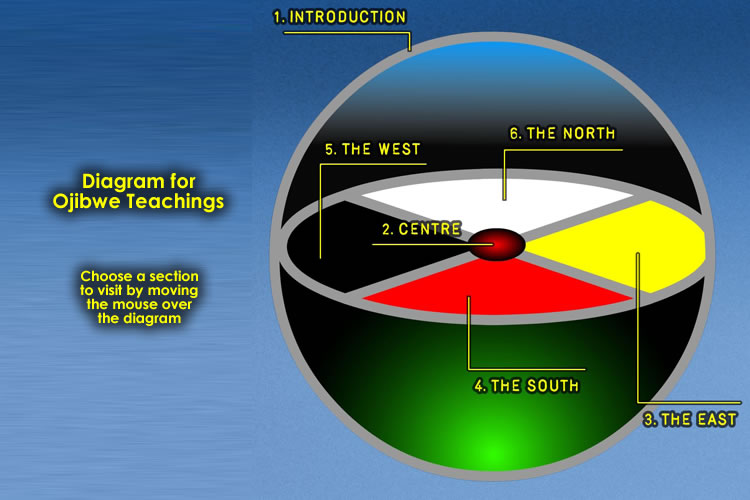
INTRODUCTION (audio narration)
Boozhoo.[1] Welcome to this sacred knowledge that’s been gifted to us, to all the two-legged that walk on Mother Earth.
These teachings that are being shared are sacred teachings. From tribe to tribe, the details may differ but the basic teachings are the same. They have been followed and shared for many, many years. So we honour the ancestors, the ones that have walked before us, because they’re the ones that sat in circles many times before, and prayed that their children and their grandchildren would follow in their path. When we honour the ancestors, we honour ourselves.
There are Seven Sacred Directions.
The Four Cardinal points on the Medicine Wheel are the Four Sacred Directions, represented among the Ojibwe by the colours yellow, red, black and white. Blue represents Father Sky in the upper realm, Green represents Mother Earth below, and purple represents the self, that spirit that journeys in this physical world, at the centre of the wheel.
The Seven Stages of Life are also found on this Medicine Wheel. They begin in the east and move across the Wheel to the West. The Seven Stages of Life are: The Good Life, The Fast Life, The Wandering Life, the stages of Truth, Planning, and Doing, and The Elder Life.
The Seven Grandfather Teachings are also located on this Medicine Wheel. They begin in the Northern direction and move down to the centre of the Wheel. These gifts are the teachings of Honesty, Humility, Courage, Wisdom, Respect, Generosity and Love.
The Teachings of the Medicine Wheel are vast. There are seven teachings within each direction on the Ojibwe wheel, and all these have sub-teachings to them, such as where all the medicines like sweetgrass came from, and what they mean.
The four directions of the Medicine Wheel remind us of many things, such as the need for balance in the world, and the balance we must strive for everyday within ourselves. Here you will begin to get an idea of a few of those many teachings and connections that are in the circle. Everything comes in fours, so it’s easier to digest, easier to learn. The four direction teachings go clockwise, beginning in the east. But before we travel around the wheel, let’s look at the Centre.
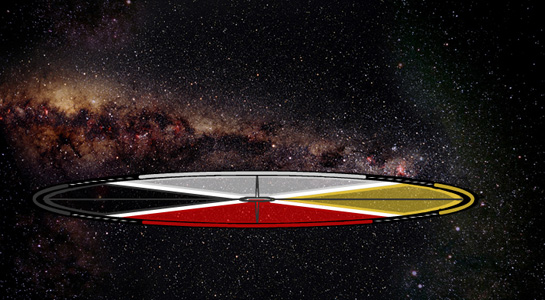
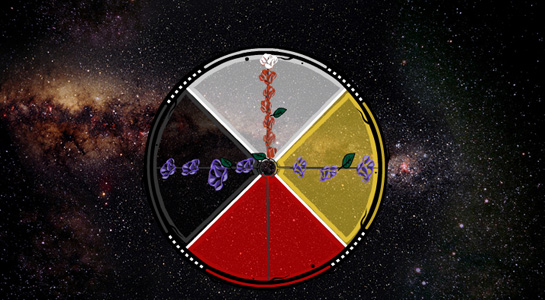
CENTRE (audio narration)
Each of us carries a fire within. Whether it’s through the knowledge we have, or through our experiences and associations, we are responsible for maintaining that fire. And so as a child, when my mother and father would say, at the end of the day - My daughter, how is your fire burning?” It would make me think of what I’ve gone through that day -- If I’d been offensive to anyone, or if they have offended me. I would reflect on that because it has a lot to do with nurturing the fire within. And so we were taught at a very early age to let go of any distractions of the day by making peace within ourselves, so that we can nurture and maintain our fire.
We have many teachings on the value of nurturance. When I was a child my father told us about the Rose Story. He said the Creator asked the flower people, “Who among you will bring a reminder to the two-legged about the essence of life?” The buttercup answered, “I will, Creator, I will.” And the Creator said, “No, you can’t, because you’re too bright.” All of the flowers offered their help. At the very end the rose said, “Let me remind them with my essence, so that in times of sadness, and in times of joy, they will remember how to be kind to themselves.”
So the Creator, the Master Gardener, took a seed of the rose and planted it in Mother Earth. The winds tilled the soil and the warm rains gave it water until a very small sprout came through the ground. Day after day it grew. The stem sprouted little thorns that were very, very sharp. After the thorns came the little leaves. As time went on, a little bud formed. After much care this little bud bloomed into a full rose.
And so life is like a rose. The thorns are our life’s journey; without them we would lack the hard won teachings that we need to in order to grow. Life’s experiences make us who we are. And like the rose, we too decay and die many times in a life time only to come back to fruition again and again, after reflection, meditation, awareness, acceptance and surrender.
My father told us the rose is both life and it’s gifts. So when I am making my own Medicine Wheel, I put the rose here in the centre as a reminder of my own life’s journey and it’s gifts.
For this, I say “meegwetch.”
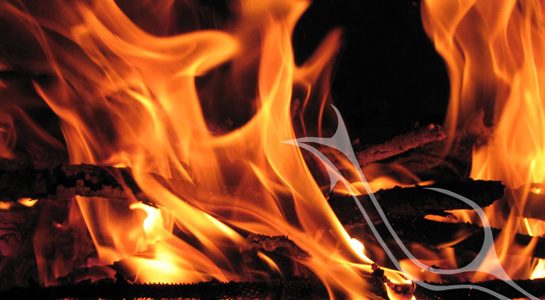
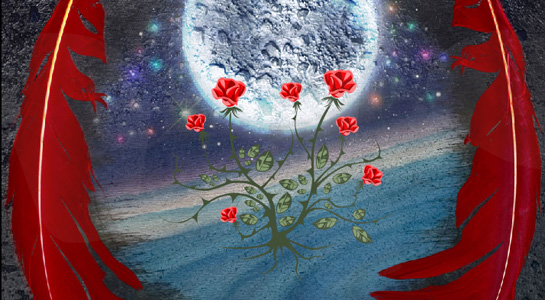
THE EAST – WAABINONG (audio narration)
The east is where we come from. It represents the springtime, and the spring of life. It is where we begin our journey as human beings coming from the spirit world into the physical world. This is Mother in here, the one that brings life.
We are born when, as a spirit, we ask the Creator to go on this physical journey. The Creator grants us this request with four gifts: the gifts of picking our mother and father, so that they will help us come to an agreement, a balance, within ourselves, and the gift of picking and choosing how we are going to be born and how we are going to die.
And so in the spirit world, we find our spirit mother and our spirit father, and we ask them, “will you be my vehicle to go to this physical world?” When they agree, Creator brings them together. A spirit is then born at the physical level, and is carried by the woman for nine months until the water breaks. We then enter into the physical world.
Our journey begins here, when Creator breathes the spirit of life into us. And the spirit is the one that motivates all that life in this great circle. We are a spirit on a physical journey, until our last breath.
Life is a gift. To honour that gift we have been given tobacco.
All life is spirit. It is the wind, the earth, the fire, the water, all of those things that are alive with energy and movement. When we talk about life we are talking about spirit, and so we give thanks every day to those things that we cannot exist without, because we need them on our journey.
That is why we begin our day with the act of thanksgiving, by taking a little bit of tobacco and gently placing it in a clean place outside: in a garden, at the base of a tree, or on the shore of a lake; a place where Mother Nature is unencumbered. When we do this we are giving thanks. We are humbling ourselves to creation and being grateful for the breath of life once more.
Boozhoo Creator, Thank you. Thank you for giving me the breath of life. Thank you for the world, for the life-giving Earth and for Grandfather Fire that warms me when I am cold. Thank you for the birds, and the crawlers, the swimmers, and the trees. Thank you for the cycles of time: the fall, the winter, the spring and summer. For all these things affect my being with their gift of Creation.
And so, we correlate Spirit with all that is called Nature, because it is life itself. When we follow natural law, it never lets us down, because natural law was the only law that existed before man put himself on the road to progress.
We have the gift of tobacco here in the eastern direction because it reminds us to be grateful for all life – grateful in the way of being humble in knowing that we will always require guidance and protection, and cannot exist without the gifts of the natural world around us.
There are many teachings that come from this eastern direction. I have shared a small part of these with you, but in doing so I have accepted tobacco to honor the request to share these teachings.
I’ve been told ever since I was a young girl by my parents that when we hold our tobacco in hand, when we ask the Creator for what we need, all our intentions are answered. Not the way that we want them sometimes, but the way the Creator wants them.
And so I honor this tobacco as I prepare myself to go on this journey with you.

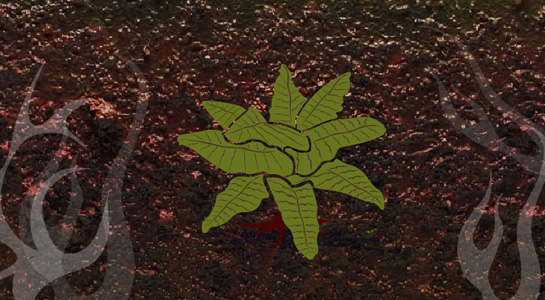
THE SOUTH – ZHAAWANONG (audio narration)
Here in the southern direction of the Medicine Wheel, everything is thriving. The trees have come awake, producing their leaves. Life itself is awake and dancing, because the summer stage is here, a time of continued nurturance for all of Creation, when everything is new and growing fast.
Youth resides here in this direction. Youth are in the quandary stage - not old enough to be an adult but no longer a child, when they are either searching for what they have left behind in their child stage, or losing that essence that is present within them, because of a lack of nurturance.
The youth is searching for something and never finding it: searching for something that they used to have. “Who am I? Where do I come from?” As a youth, we look to remember our humble beginnings as the child; we search for that.
The southern direction reminds us to look after our spirits. When you are in balance within yourself, spirit will warn you of danger, will tell you, “No, don’t go there. Go this way instead.” So no matter what happens, when you listen to that spirit, to that intuition, it never deceives you. It’s always right, because that’s your guide. When that is disrupted, kids grow up without any direction, without any spirit nurturance. And they grow up to be teenagers, and they’re into all kinds of dangers and distractions. Why? It’s because there’s no spirit foundation. Their spirits have not been nurtured. And their youth, their wandering stage, becomes very distant.
They have a long way to go before they catch up with themselves again, and the truth about who they are. As a youth, I have to find people to help me in that time of continued growth, so I hook up with like-minded people to give me that nurturance that I think I need. And when our elders come in and say: “We have something for you; this is a gift I have for you; take a look at it; see what you think of it” - they’re not saying, “I want you to follow these teachings.” No. The elders are inviting them; as an elder, I invite the youth to be a part of my journey. And with that invitation, most of the time, they join me, just to hear out what has life, what has meaning, what has purpose. And their lives begin to change. They begin to take accountability, to form a life style. They’re planning now to be a better parent, to have a career, all of that. That becomes their truth.
And so, looking at this life’s journey, how it used to be, and how it is today, where do we find the balance? We need to go back to our humble beginnings. We need to make contact with our ancestors, and say, “Please, have pity on me; pray that I will find my journey.”
And so the youth reminds us to be mindful in our struggles, to remember our humble beginnings as the child, and to nurture the youth themselves, who are searching, because they are still growing and in need of our guidance and protection.
That is why summer is the time of continued nurturance, where we learn to cultivate our spirits.
The gift of cedar was given to help us in this direction.
The Cedar Grandmother was asked by Creator, “Will you walk with these two-leggeds? Will you provide them with your medicine when they are hurting and when they are ill?”
Our Grandmother agreed, and so to this day we honour that cedar tree, because she is the Grandmother who comes to us free of charge to administer that medicine when we ingest her and drink of her sacred teas.
And so we are reminded that spirit lives inside of us, and that to nurture spirit means we must be mindful of it, lest it should run away.
Grandmother Cedar helps us; with her medicine she takes from us all those things that we don’t need on our journey. Once we’re ready to give them up, she takes them from us and makes us anew. That is why cedar is considered a cleansing medicine for body and soul.
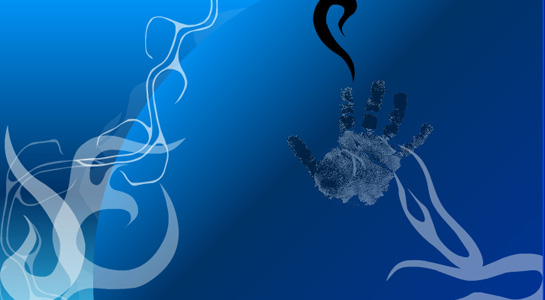
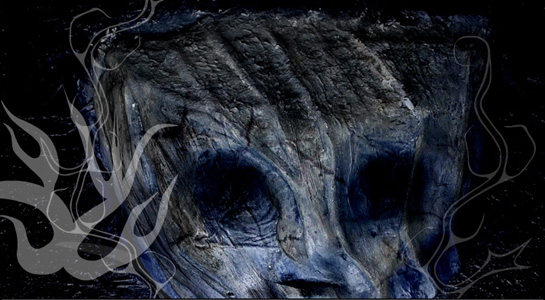
THE WEST – EPANGISHMOK (audio narration)
The western direction is the adult stage, the berry stage. It is here that the growth from summer has come to ripen. It is the time of harvest, and so for much of creation the physical journey is over, and that life crosses back into the spirit world.
The sun setting in the west signifies the death of a day. And so we die many deaths in a lifetime. And just as an old thought or feeling dies, and a new one emerges, we die many deaths in a single day. So there is constant change within us. We dance around that western doorway many times in a day to honour the death spirit.
As we move through adulthood, death and loss become more and more visible. In the light of death, it is important that we accept that constant change is here with us.
The west also represents the heart, the evaluator of what’s going on in my life. As adults, we need to be in touch with this evaluator, because it helps us to see the cycle of life, to appreciate and enjoy the fruits of life, and to accept aging and change, making peace with our lives and deaths. We are given the responsibility to nurture our hearts, so that we may be in balance, and see the Medicine Wheel for what it is.
And so to help us we have been gifted the medicine of sage. When we smudge ourselves, burn the sage and bring the smoke over our bodies, we are given the gift of clearing our minds and hearts, so that we may prepare well for the rest of our journey.
The Strawberry Teaching comes to mind here in the west, because it teaches forgiveness and peace. The Strawberry is shaped like a heart, and strawberries are known to our people as heart berries. We were taught stories like these from a very early age.
A long time ago, there was a family that chose to no longer live in their village because of community feuding and ill will. This young family took their two little boys and said, “Let us go back into the forest, and we’ll let the trees nurture our children; we’ll let the birds sing songs to remind them of their own songs. And we’ll let the animals become their friends.” And so they packed up their little boys and went deep into the forest.
The father offered his tobacco, and asked the tree nation to give him a home. He was granted that gift and so he cut down the trees. He made a home for his family and they moved in. The boys grew tall and strong, and yet year after year they continued to play fight and wrestle. Finally when they were in their teens, their mother said to them, “It’s time for you to give up your childish ways.” And they said, “Okay mom, we won’t wrestle anymore.” But as soon as they were out of earshot from their mother, they said, “Let’s go deeper into the forest and we’ll build a wrestling ring for ourselves, so we can go out there any time we feel like it.” And so they did. They cleared some land and went there secretly, without their mother’s knowledge.
And then one fateful day the time came when the boys were wrestling and the older brother knocked his younger brother to the ground, where he hit his head on a rock and died instantly. The oldest brother was beside himself. He said, “Please, please wake up… Mom and Dad are going to kill me. Please, please answer me.” The only answer was silence. He cried and begged his brother: “Please, please.” Finally after a couple of hours, a voice told him: “Bury your brother.” And so he dug into the ground and put his brother there. He covered him up and ran home.
Out of breath, he ran to his parents: “Mom, Dad, I’ve lost my brother in the forest - I can’t find him.” And so the parents went out with him and they looked. They couldn’t find him anywhere. The father said, “I will go into the community, and seek out our relatives to come and help us form a search party so we can find him.” So they searched for ten days, and ten nights, and then they went into mourning after they couldn’t find their son.
But every day the brother would go to his little brother’s grave, and he would say, “Please, please tell me that you’re okay! Please!” And he would cry as he walked away, because he had no answer. And years went by. He carried this sadness into his manhood because only he knew where his brother’s body lay.
After many years and visits to his grave, the elder brother saw a tiny plant. He watched it grow into a little strawberry vine on top of his brother’s grave. Each day he watched the leaves grow and the berries come into fruition.
White heart-shaped berries appeared first. Then, over days, they transformed into big red delicious berries, luscious and sweet. As he contemplated them, a voice from inside him said, “Take a berry and eat it.” So he picked a berry and he put it in his mouth.
As he ate it, he became aware, for the first time in his life, that he could taste the sweetness of life again. No more did he blame himself for his brother’s death, and no more did he blame his brother for not answering him. He no more blamed his parents for their strict upbringing. And most of all, he no more blamed the Creator for taking his brother’s life. He was free. After all of these long years, he was finally free.
And so here in the western direction we have learned something about death and about the power of change and healing, and that finding peace doesn’t necessarily come from the head – it comes from the heart. Death can be a place of freedom: freedom to go on, freedom to be. It’s very important to remember that, because only then can we go on to enjoy the northern direction after we have given careful consideration to these teachings in the west.

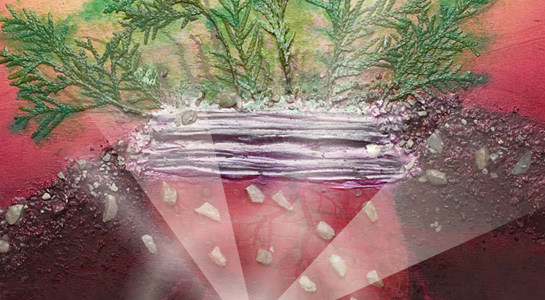
THE NORTH – KIIWEDINONG (audio narration)
Now it’s time to slow down from the business of birth and death, the continuum of death and rebirth. Here in the Northern direction is the rest period. Some call it the remembrance period, because after death, you rest, and you contemplate what has happened. But rest is also used here to be mindful of the physical body, to remember to care for and nurture our physical bodies: when they are tired, rest them, just as in the winter the Earth rests from her labours. When they are hungry, feed them. And know what you are ingesting, what is good food for the body.
This is a time of reflection on being a child, a youth and an adult. And so it is here that we honor our Elders. This is where they reside, along with the pipe carriers and the lodge keepers, because their ceremonies provide us with teachings of the whole Medicine Wheel, in all the directions. They also help us make peace through embracing all those aspects of ourselves - the child, the youth, and the adult - so that we may be able to feel and experience the fullness of self.
This is a place of wisdom.
And so it is here during the winter months that the elders share their stories and teachings. In honour of this storytelling time, I too will share a story.
Years ago we were prohibited from visiting Dreamer’s Rock. It is a sacred place in our territory where our people would go for vision quests. In 1968, that ban was lifted and we were able to go back and do our ceremonies. At this time I became involved with the community because I believed in the value of our teachings and ceremonies. But I had to first regain that fire.
I will never forget it. In the first sweat lodge ceremony, the elder told us that the spirits that came into the lodge were hungry. He said, “I asked them what they needed and they said, “Bakademe – zhamzhenung.” This Elder was not of the same dialect as me, but he brought those words from the sweat lodge. He said it means, “We are hungry; feed us.”
Something inside of me stirred. I remembered as a child, my grandmother used to say, “We will feed them, those that went ahead, our grandmothers, our grandfathers, all our relations.”
She would then prepare food and burn it on the stove, until the smoke from it permeated the whole house. It was like the essence of their lives filled our home and reminded us of how they contributed to our life’s journey. And that was a good feeling.
I knew then, deep inside - Spirit spoke to me - I knew what I had to do.
And so I went back home and called every household I knew. I said, “We’re having a celebration. Can you donate some food?” “Yes - yes, yes,” – everyone agreed. People were awakening to something that they knew existed before.
So we prepared the spirit plate. Every spoonful of food that was donated was put on that plate. And it was a heaping plate because there was so much food. We took that plate along with our tobacco to the fire and prayed: “Please hear us,” we said.
“Grandfathers, grandmothers, ancestors, all our relations: please hear us. We are here now, have pity on us. We had forgotten to feed you. You have lived a long time without food, and now we are here to honour you. Please come and feast with us.”
As we put the food down, I could actually see those spirit hands grasping for that food because they were starving. It was at that moment that I began to cry because I could feel my reconnection to this circle.
And so as I share this story with you, I am sharing how I became reconnected with my ancestors. It is through them that we learn the sacred teachings that they carried. I cherish this story because it is not only about an awakening inside of me, but an awakening of a community that came together to celebrate a way of being and spiritual nourishment. We still go back to our original teachings, because that’s where our food for life comes from, to nurture that spirit that is forever searching in life’s journey.
And so I am grateful to all of my teachers and all of life’s teachings.
This is what we learn from the four stages of the Medicine Wheel: that all of life’s cycle is beautiful - the sadness and the joy, life and death; and that they are all one, and there is life in death, death in life - and that beauty itself resides within the balance of the whole circle.
And so now we have come full circle, and I give thanks. To the Eastern Doorway I say Meegwetch, to the Southern doorway, I say Meegwetch, to the Western Doorway, Meegwetch, and to the Northern doorway, Meegwetch.


THE SEVEN STAGES OF LIFE
The Good Life
After birth, the first seven years of our lives is the good life. I’m going to present the ideal first, the way it used to be. And so the first seven years of a child’s life, there were elders, grandmothers, grandfathers that provide for all the needs of that child, unconditional love for that child, and discipline, and the child came to know what life was all about, confident in who they were. And so the teachings began very early in life. The support family was there - the mothers, the fathers, being supported by their mothers, their fathers, and the child became strong.
And by the time they were seven years old, they were put out on their first day fast to make them realize that these are all their relations that we walk with. So the child goes out to fast for a day, for a night, with all the support people.
The Fast Life
After that, the child was prepared for the next leg of the journey, and that was called the fast life. This was when the child was being prepared for their four-day vision quest at the time of puberty. And men were designated to look after the boys, women designated to look after the girls, to train them. So that after their fasts they would be inducted into the men’s circle for the boys, and the women’s circle for the girls, so that there was always space for every individual. No outcasts in the circle. Everybody was included.
The Wandering Life
The next part was the wandering stage, where I go and wander about from place to place to find my teachers, to find other experiences. The wandering phase. It’s also to wonder about life: “I wonder, if I did this, what would happen?” So there’s two wanders in there: w. a. n., and w. o.n. - the two wonders of life.
Truth
And so when we finish going through the wandering life, our elders, or our teachers, our mentors that we picked out, are the ones that guided us to the next phase, which was the Truth Stage - the truth being, taking a look at myself, that I can see my mirror. These are my gifts. This is what I’ve learned from, and being able to speak out of that truth of self.
Planning
And then comes the planning stage. “What am I going to do with all of this information that I have? How will I accomplish it?”
Doing
And then after the planning stage comes the actual living out of it; practicing all those things that I have learned on this life’s journey, to exactly where I’m at, there.
Elder
And then to be inducted into the elder’s circle. And all of those intervals, every seven years, they would fast for direction and guidance. So then when they become elders, they come back and they teach the young ones. So there was always that circle of teaching. There were always professors there. Always teaching, always sharing.
And for every one of the Seven Stages of Life, it took about seven years - seven years to accomplish all of that.